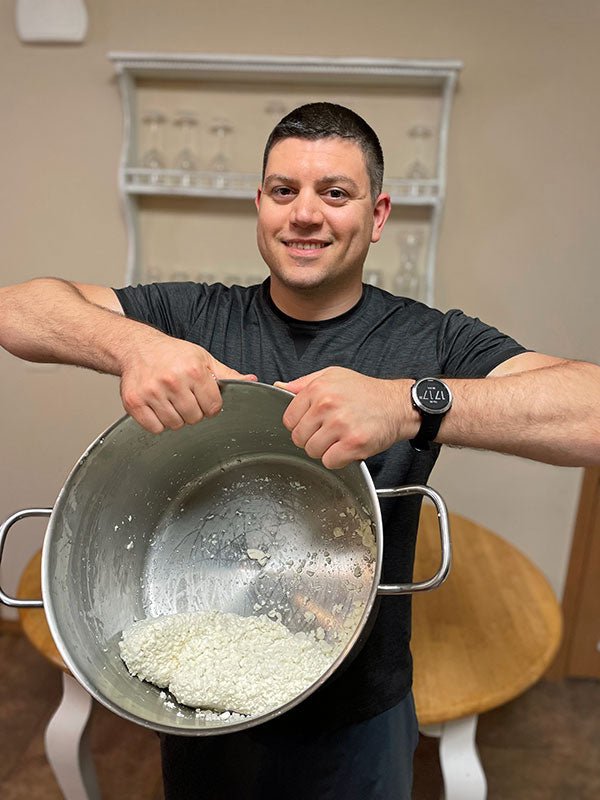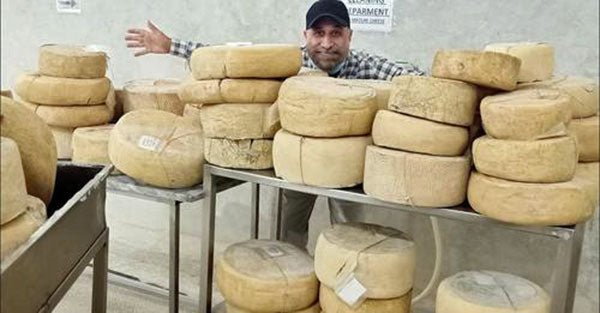I live on 45 acres of beautiful land on the Sunshine Coast with an abundance of forests, creeks and bees. A lot of my time is spent mowing, restoring the forest and gardening.
If I have any spare time, it is usually taken up with planning the next trip. (Pre-Covid, I had travelled the world extensively, especially spending time in developing countries such as Uganda).
I have lots of hobbies – making up for the many years when I was very busy raising a family and working. I am retired but I have to limit my hobbies – otherwise I will run out of storage space (and maybe time and energy). And, of course, I need to have time to work with my husband to keep our property looking beautiful.
Six months ago, a girlfriend of mine (Jo) talked me into going to a cheese making workshop with her. It took quite a bit of coercion, but eventually I said yes – a decision neither of us have regretted.
The class was a local, half-day Introduction to Cheese Making course with Elisabeth Fekonia at Peregian Beach, Sunshine Coast, Australia.
One of the main take-away points was hygiene – ensuring all your benches, saucepan and tools are very clean, washed in hot water and left to air dry.
Something else we learned was that cheese is not that hard to make (even made some with my young grandchildren), however, it does take a bit of time.
And finally, using milk with the highest protein content may cost more but you will get more cheese than if using cheaper “homebrand” milk.
After the workshop, Jo and I decided to make cheese together (over a drink) and separately.
After searching the “op shops”(second hand/charity shops) for some basic equipment, purchasing the rest, buying some starting ingredients, and looking for the “best” milk, we set aside a few hours to make some cheese.
Our husbands supported us by staying out of the kitchen, however, they did prepare some wine and nibbles for us to eat during the many cheese waiting times.
To date (and still counting), we have made quite a few kilograms (pounds) of yummy homemade cheese.

Jo carefully measuring out the ‘starter,’ as you need to be accurate with the very small units of measure.
I started by making cheeses that I love – halloumi, cheddar, colby, mozzarella, and of course ricotta. Sometimes the cheese hasn’t turned out, so, it has ended up being eaten by the neighbour’s chickens.

Breakfast tastes so much better if the ingredients primarily come from your land or kitchen – homemade halloumi, homemade wholegrain bread and home grown parsley.
Pressing the cheese is an important stage in cheese making (though bit boring). For the first press, up to 6 kilograms (13 pounds), I use milk containers. A few times these containers have off balanced, fallen to the ground and broken, spilling water everywhere ☹.
So, now I don’t go over using 2 x 3 litre (quart) milk bottles and I stand them next to each other rather than on their side. Whilst pressing, the whey drips out, so I place it in a tray deep enough to collect the dripping whey.

Pressing a smaller cheese round. Here I am using small cheese baskets, but they didn’t have a ‘follower’ so I made them out of yoghurt containers, then pressed with tins that perfectly fitted the baskets.
When more weight is required, usually when pressing the second time, I use weight-lifting weights. (Jo uses a cheese press her hubby made.) I place the cheese while it is pressing into a large plastic tub which safeguards against the weights toppling off, thus contaminating everything.
Furthermore, sealing the cheese in a tub keeps away bugs from feasting on the cheese. I usually do this press in the shed as I don’t need to bring the weights into the kitchen. I picked up the weights from an ‘op shop.’

When I need more weight to press the cheese, I place my cheese (in their containers) into an aluminum tray which is placed inside a large plastic tub. Then, I place the weight-lifting weights on top of the cheese baskets.
As we all know, most cheeses need tIme to mature, but this takes space in the refrigerator, so I use an old car fridge to store my cheese. The space is also used to store some out-of-action honeycomb frames.
My kids, grandkids (and friends) love the cheese I make…I don’t think it is just that I made it, but that it tastes pretty good, too.

My favourite tool is my good quality, heavy based stainless steel 10 litre pot (2 1/2 gallons). My next favourites are my cheese baskets and cloths.
I make cheese because I love looking in the pantry or the refrigerator and noting all the home grown/made products. My goal is to never buy cheese again.
Some of my other hobbies:
Sewing …
Embroidery …
Mosaics …
Making jam …

The pantry is full of jams and preserves that I make from produce from our garden or from locals. Tomatoes were plentiful so, lots of green tomato jam and red tomato relish were made.
Making wooden signs by routing slabs of timber from our property …

Every property needs a few signs so you don’t get lost. These signs are on tracks around the property.
A bit of gardening (vegetables and fruit in particular). We only grow what we like, and only in quantities that we can eat, preserve or swap.
. . . and everything to do with bees (bee keeping, honey and wax products).
Our bees are beautiful – and give us much pleasure in looking at them, looking after them, and making use of their products. We love honey.
I also make beeswax candles, waxed wraps, lip balm and lotion, and bees wax furniture polish.

































































































































































